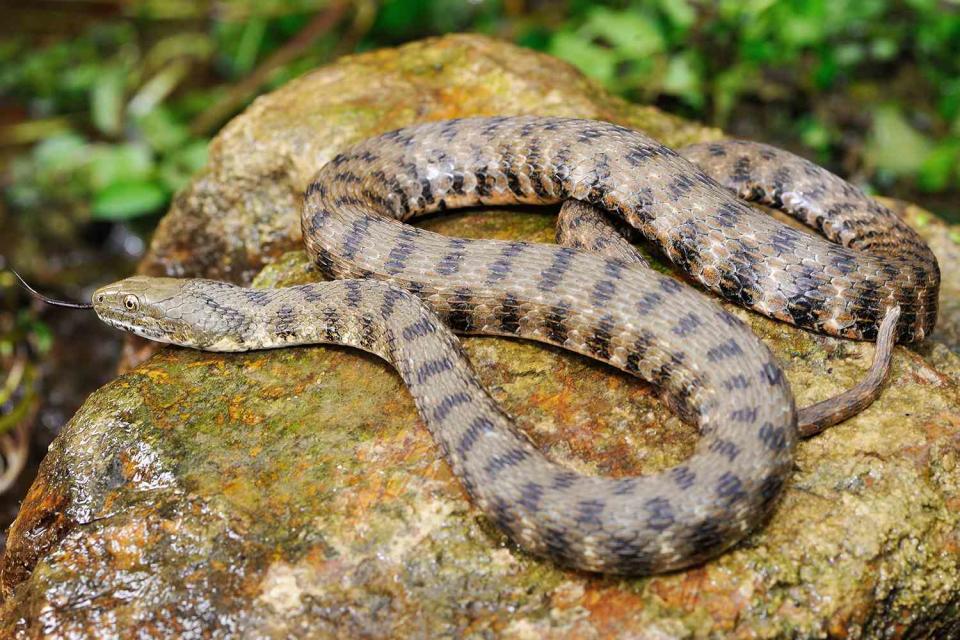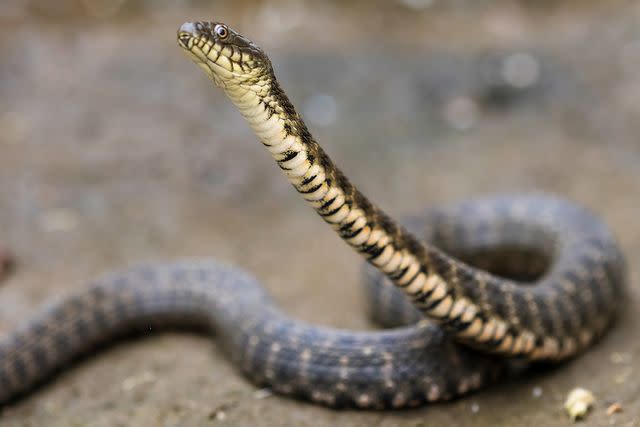Some Snakes Stage Elaborate Fake Deaths (and Cover Themselves in Bodily Fluids!) to Escape Danger
Dice snakes excrete poop, musk, and mouth blood while feigning death, a new study found

mauribo/Getty
A dice snakeAnd the award for best fake death goes to — the dice snake!
A new study published in Biology Letters on May 8 found that the reptile doesn't just fake death to protect itself from predators (a common occurrence in the animal kingdom) but also adds dramatic elements to its death display to make it more convincing and to spend less time in dangerous situations.
Conducted by Vukašin Bjelica and Ana Golubović of the University of Belgrade in Serbia, the study found that the reptile, whose scientific name is "Natrix tessellata," uses a series of theatrical tactics — called anti-predator defenses — many of which involve bodily fluids.
Related: 41 Indigo Snakes — the Longest Snake Species Native to the U.S. — Released in Florida
Specifically, while faking their demise, dice snakes’ defenses include producing and smearing themselves with excrement and musk, as well as purposefully ejecting blood from their mouths.
To investigate these tactics — and whether they make for a quicker escape — Bjelica and Golubović examined 263 of the nonvenomous snakes on Golem Grad, an island in southeastern Europe where the reptiles are common and their main predators are birds.

redstallion/Getty
Golem GradOn the island, the biologists conducted hands-on research — literally.
Acting as the predators to provoke the snakes’ death-feigning tactics, they held, squeezed and stretched out the animals, according to the New York Times. Then, they noted their reactions.
A little less than half the snakes smeared themselves with musk and feces, while about 10 percent of them oozed blood from their mouths, the outlet said.
Related: Rattlesnake Gives 2 Friends Nightmare Fuel After They Catch Reptile Swimming Toward Them
Some dice snakes were more convincing — becoming so limp the researchers could mold them into shapes — while others remained somewhat limp. In Bjelica's words, "They really commit to the role, depending on the individual."
As the researchers hypothesized, snakes that opted for a more dramatic approach — not only going limp but also bleeding, masking, and defecating — tended to play dead for longer (by about two seconds) and therefore spent less time in danger, according to the New York Times.
While two seconds may not sound substantial, the time could make a huge difference in a life-or-death situation. It "could be enough for a snake to make a successful escape," Bjelica said, per the newspaper.
Never miss a story — sign up for PEOPLE's free daily newsletter to stay up-to-date on the best of what PEOPLE has to offer, from juicy celebrity news to compelling human-interest stories.

Wim Verhagen/Getty
A stock image of a dice snakeBjelica also noted that further study — ideally real-world observation with predators who are not human researchers — is needed.
"We're not trying to hurt the snake, so you're not going to grasp and handle them like a predator would," the researcher pointed out. "But the predator is not thinking in terms of ethical restrictions or methodology sections in a research paper."
Another scientist, the University of Helsinki's Katja Rönkä, noted in Science News that the predator side of death-feigning behavior warrants further explanation.
Speaking with the outlet, Rönkä posed the question: "Why are they deterred by 'dead' animals, especially since they just saw them alive?"
For more People news, make sure to sign up for our newsletter!
Read the original article on People.


